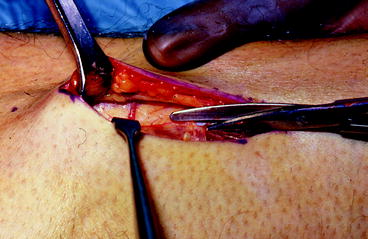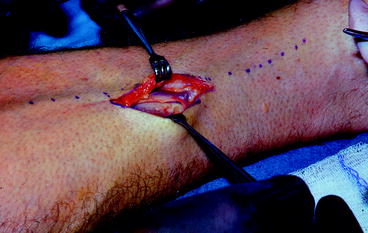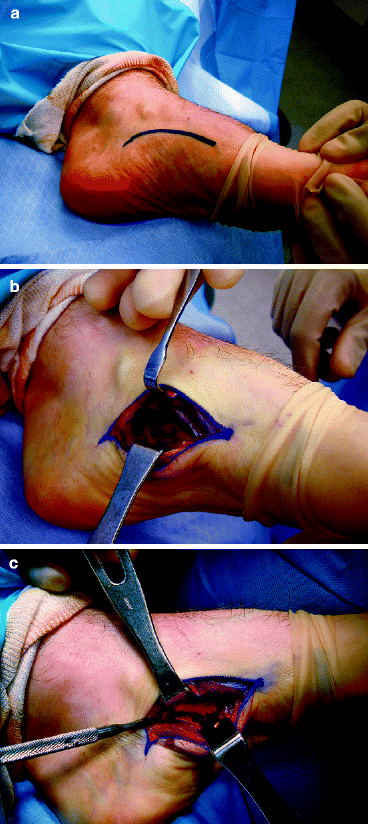Fig. 12.1
Compartment pressure measuring device
12.8 Treatment
Treatment options for CCS include living with the problem, conservative treatment, and definitive surgical fasciotomy of the involved leg and foot compartments. If the patient opts to live with their problem, they must be made aware that they will be at increased risk of ACS due to the patient being less tolerant to increases in compartment pressure.24 Education about both forms of ACS is mandatory so that the patient knows what to expect if this medical emergency occurs.
12.8.1 Conservative Treatment
Conservative care is symptomatic and mainly consists of avoidance of offending activities and participating in other activities “to tolerance.” Anecdotal reports of deep massage have been shown to be beneficial for CCS of the leg.25 Foot orthoses should be avoided as they have been shown to aggravate the symptoms of CCS of the leg by increasing intra-compartment pressure during exercise.26 If foot orthoses are attempted for CCS of the foot, then at least a half-size larger shoe is recommended to avoid further shoe constriction. Elimination of external factors causing constriction is paramount. Transient CCS typically responds to conservative treatment and surgery should not be needed. An initial period of rest is followed by a graduated exercise program designed for the desired activity.
12.8.2 Surgical Treatment
Based on the author’s clinical experience with CCS of the leg and foot and supported by results reported in the literature,4,14–17,27–33 surgical open fasciotomy of the involved compartments (confirmed with CPM) is curative and should be considered the treatment of choice.
Surgery for CCS of the leg requires a fasciotomy through a distal anterolateral approach to decompress the anterior and/or lateral compartments and a distal posteromedial approach to decompress the deep and superficial posterior compartment. The fasciotomy is extended proximally and distally over each involved compartment to encompass the entire length of the leg. A proximal accessory incision can be made to supplement the distal incisions if proximal exposure is needed. Care needs to be taken to protect the superficial peroneal nerve anteriorly and the saphenous nerve and greater saphenous vein posteriorly (Fig. 12.2). Once the vital structures are protected, fasciotomy with Metzenbaum scissors is performed (Fig. 12.3).



Fig. 12.2
Saphenous nerve visualizes through posteromedial incision

Fig. 12.3
Fasciotomy of deep posterior compartment
Surgery for CCS of the foot requires a medial approach using a longitudinal linear incision centered over the abductor hallucis muscle belly extending distally to the myotendinous junction (Fig. 12.4). If a hypertrophic or accessory muscle is encountered, then a muscle debulking or accessory muscle excision can be performed respectively. By mobilizing the abductor hallucis muscle, the superficial and calcaneal compartments can be decompressed as well if indicated. Care needs to be taken to avoid injury to the medial and lateral neurovascular bundles during this procedure.


Fig. 12.4
(a) Medial incision for foot fasciotomy in a patient with CCS of medial and central compartments. (b) After dissecting below abductor hallucis, vessels are evident. (c) Fasciotomy exposing central compartment musculature (Photos courtesy of Amol Saxena, DPM)
Postoperatively, a Jones compression dressing is applied for 1 week, followed by use of a removable splint for up to 3 additional weeks. The patient is kept non-weight-bearing during this time followed by 2 additional weeks in a short leg walking boot. Physical therapy is usually initiated at 3 weeks with emphasis on gentle stretching, early range of motion exercises, soft tissue mobilization, and general conditioning. Though considered on a case-by-case basis, return to running sports can usually be considered at 8–12 weeks post surgery.
12.9 Summary
CCS of the leg and foot is an uncommon though important cause of lower extremity pain. CCS is classified as a claudication syndrome characterized by no symptoms at rest though symptoms occur with exercise. A broad differential diagnosis of various entities that comprise claudication syndrome should be considered and appropriately ruled out in a systematic fashion. The four criteria for diagnosis of CCS should be apparent, and if these criteria are met, then CPM should be obtained to validate the diagnosis. If a course of conservative care is not successful, then compartment decompression via fasciotomy is indicated and should be curative. Expected result from surgery should be excellent with few complications.









